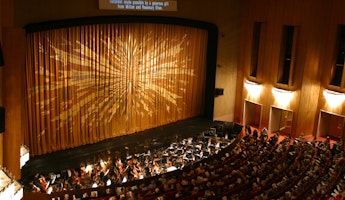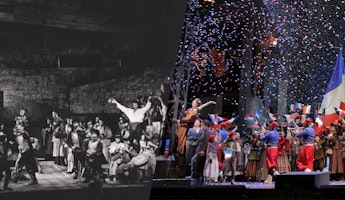Blog
August 11, 2021
Secret Sounds: Inside the Anvil Chorus
Any opera aficionado will tell you that the Anvil Chorus in Il Trovatore is an iconic piece of music. Odds are you’ve heard it in movies, shows or commercials without even realizing it. If you're not a professional percussionist, you might think music as grand as this requires some specialty instruments to perform. But according to Theresa Dimond, an actual professional—in fact, she's the principal percussionist of the LA Opera Orchestra—that's not the case. Read on to get the inside scoop on the secrets of this piece's extraordinary sound.
SO, CAN YOU LET US IN ON THE SECRET OF THE ANVIL CHORUS?
Here’s the deal. You'll get a lesson in metallurgy today—the things we percussionists have to know! Verdi writes for anvils with two pitches, high and low. You need two metal sounds. If you think about what an anvil looks like, they’re large, heavy and dense. Real anvils have a remarkably high-pitched ping when you hit them, and they don’t vibrate very long because of how large they are.
Usually we take three metal pipes, each picked on the sounds they have. They kind of match the key the Anvil Chorus is in. We place them on a table, and we hit them two at a time: the low-pitched one and the middle-one, then the middle one and the high one.
WHERE DO YOU FIND THESE PIPES?
Home Depot is my friend. I get them there. It’s the kind of pipe you use in plumbing, and you can find something sonorous—I have a sound in my head I'm trying to match. The pipes are large, maybe between 1 ½ and 3 or 4 inches in diameter; the longer the pipe the lower the pitch. You want something “masculine sounding.”
YOU CAN’T GET THEM IN MUSIC STORES?
There are real anvils you can buy—manufactured, no joke, by the Acme Company—but it's surprising how pingy and high they sound. They're sort of a metal brick, 12 inches long and hollow, and about an inch high. They’re too clanky. My guess is that they’re used for sound effects or maybe back from the vaudeville days. In Il Trovatore, the anvils are meant to be musical. Pipes are more resonant and have a nice “after ring.” Making metal sound beautiful is my job.
WHAT DO YOU USE TO HIT THEM WITH?
We have two very small ball-peen hammers. It has to be a blacksmith sound, so that's what we use. You could use a brass mallet, but you’d end up losing the battle; that would be a great way to ruin your mallets. The people around you may not like you very much, but the audience loves it, so in some ways it’s the most fun to play and in some ways it’s not.
IS THERE ANYTHING ELSE LIKE THAT IN THE OPERATIC REPERTOIRE?
It's akin to Foley; you're adding a sound that’s portrays something going on onstage. We're always portraying midnight backstage with chimes. When we did Moby-Dick, we needed to make the sound of Captain Ahab's wooden leg. In The Ghosts of Versailles, we had various knocking sounds on wood. It becomes a Foley art, and it's always assigned to the percussionists.
Sometimes you have to try to imagine what the composer had in mind. In Madama Butterfly, Puccini writes for something he called campanelle giapponese, “Japanese bells,” but it’s not clear exactly what those were, so I use a tubaphone, another metal instrument. Puccini also writes in The Girl of the Golden West for some kind of instrument they apparently had in Milan. But nobody knows what it was, so we substitute a vibraphone. A lot of times we get hints about what the composer wanted.








/03-cosi/_dsc0996_pr.jpg?format=auto&fit=crop&w=345&h=200&auto=format)















